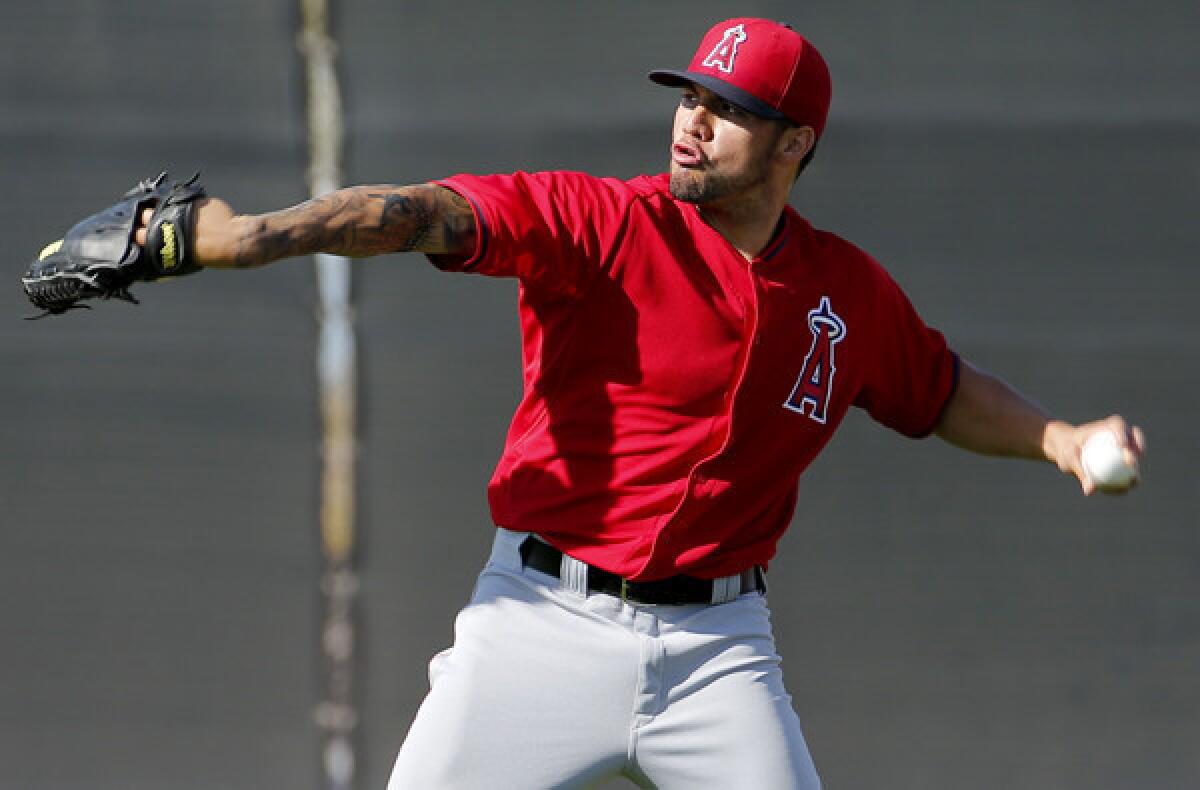Angels’ Hector Santiago has his head screwed on straight

TEMPE, Ariz. — Hector Santiago does not have a personality that matches his signature pitch. A screwball, the new Angels left-hander isn’t.
Mature, hard-working, dependable, gregarious — these are among the adjectives that describe Santiago, who was acquired from the Chicago White Sox in the three-team Mark Trumbo trade.
The son of a flooring-and-carpet installer and hotel housekeeper, Santiago, 26, grew up in a blue-collar section of Newark, N.J., resisting the temptation of drugs and gangs by staying in school, playing ball in the afternoons and rising at 5 a.m. on the weekends to work with his father.
Two years into a big league career in which he has made $1 million — a small sum by major league standards — Santiago has already been recognized for his charitable work. The White Sox nominated him last season for the Roberto Clemente Award, given annually to a player for his service to the community.
After reaching the big leagues in 2011, Santiago returned home in the winter to help his dad lay carpet. He still phones his parents three or four times a day.
Though he hasn’t thrown a pitch for the Angels, Santiago is already a fan favorite, interacting regularly with his Twitter followers. Heck, even the Florida junior college he played at — Okaloosa-Walton — is in a town called Niceville.
“I always told him, no matter how far you go, don’t forget where you came from,” Hector Santiago Sr., said by phone from Newark. “He has a good head on his shoulders. He’s always kept his nose clean. He knew what he wanted in life. His goal was to make it to where he’s at now.”
The elder Santiago, 48, began pushing a broom in a flooring company when he was 11 and has been there ever since.
He never imagined his son would rise to the big leagues and make six-figure salaries. He cried in July 2011, when Hector told him he was promoted to the majors.
“He said he was going to ‘The Show,’ and I said, ‘A TV show? Are you making movies now?’ ” Santiago Sr. recalled. “I never heard that term. From where he came, for as hard as he worked, for him to get that call … it was a dream come true.”
The screwball made it possible.
Santiago was playing catch before a 2009 winter league game in Puerto Rico when former Milwaukee left-hander Angel Miranda told him he had the perfect arm slot for a screwball, an off-speed pitch a left-hander turns over to break down and away from right-handed hitters.
The pitch felt natural, but a fear of injury prevented Santiago from throwing it for two years. But with his career stalled at Class A for a fourth season, Santiago figured, “What do I have to lose?”
He threw the screwball extensively in spring training and went from Class A to double A to the big leagues in four months.
“It definitely opened some eyes,” said Santiago, whose screwball sits at about 73 mph, 20 mph slower than his fastball. “It was the pitch that got me to the big leagues.”
Santiago hopes it’s the pitch that keeps him here, as do the Angels, who are counting on Santiago and young left-hander Tyler Skaggs to shore up the back of a rotation that struggled in 2013.
“It’s very funky, a pitch not a lot of guys throw,” Angels catcher John Hester said. “It’s a very different look. It’s a super-slow changeup that moves and darts and drops to the floor. I would think it would be very difficult to hit.”
Manager Mike Scioscia caught one of the most famous screwball pitchers in history, Fernando Valenzuela, but said it was hard to compare the former Dodgers left-hander to Santiago because Santiago throws his fastball much harder than Valenzuela.
“We saw it last year — it’s a terrific pitch, a legitimate screwball, and he has really good action on it,” Scioscia said. “He also has a plus fastball, so where he uses the screwball will be contingent on the situation in an at-bat. Certainly, it will be part of the package he uses to put hitters away, but not exclusively.”
Santiago, who also throws a changeup, slider and cut fastball, opened 2012 as the White Sox closer, but he relied almost exclusively on his fastball, fell behind on too many counts, gave up four home runs in April and was demoted to long relief.
He was sent to triple A that August to start and spent most of 2013 in Chicago’s rotation, finishing 4-9 with a 3.56 earned-run average, striking out 137 and walking 72 in 149 innings in 34 games, 23 of them starts.
If Santiago gains better control of his fastball, he can use his screwball more than the seven or eight times per game he threw it last season.
“If I was ahead in the count more, it would have been a bigger pitch for me,” Santiago said. “The difference in speed makes my fastball better and puts something in the hitter’s mind.
“They’re saying, ‘Hey, he’s got another pitch, I can’t just sit on a fastball here.’ I’ve seen 101-mph fastballs turned around and driven over the fence, so a 94-mph fastball is not a big deal to them.”
Twitter: @MikeDiGiovanna
More to Read
Get our high school sports newsletter
Prep Rally is devoted to the SoCal high school sports experience, bringing you scores, stories and a behind-the-scenes look at what makes prep sports so popular.
You may occasionally receive promotional content from the Los Angeles Times.







